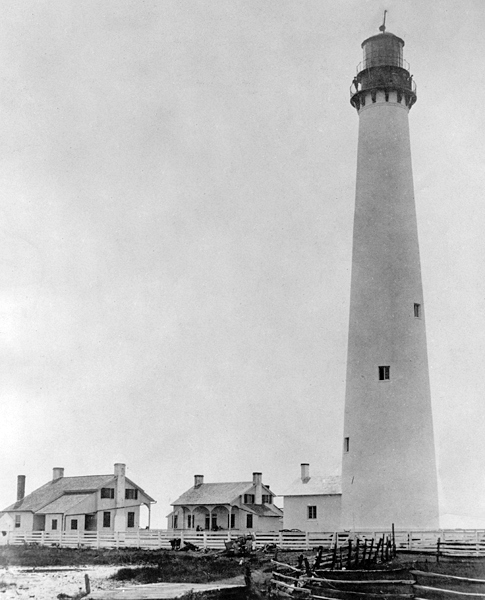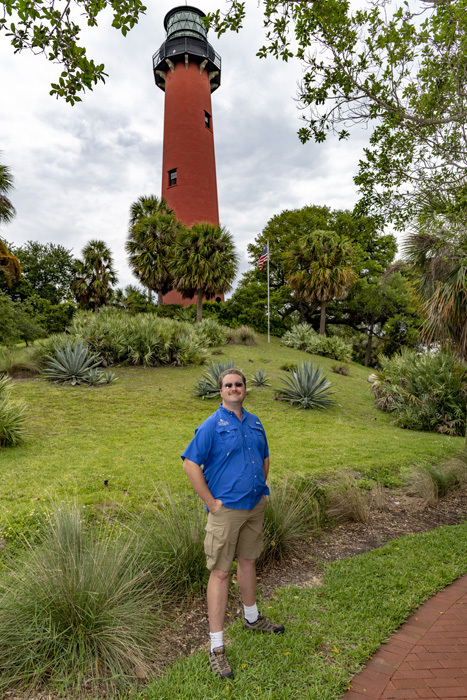
William Franklin Raynolds was born in Canton, Ohio in 1820. He graduated from West Point 5th of 39 in the Class of 1843. One of his classmates was Ulysses S. Grant. Head of the class was William B. Franklin, of whom more will be said in a subsequent column.
Between 1843 and 1856, Raynolds served primarily on surveying projects on the Great Lakes and Canadian border. During the Mexican War, Raynolds was an staff officer in the armies of Zachary Taylor and Winfield Scott.
On 1 June 1856, Lt. Raynolds succeeded George Meade as head of the 4th and 7th Lighthouse Districts; he soon added the 5th District as well. Raynolds continued numerous projects started during Meade’s tenure and refined several of them that had not yet begun. In particular, Raynolds modified Meade’s design for Jupiter Inlet Lighthouse to include a double wall, substituted granite brackets for iron, and made the tower slightly taller. It was also Raynolds’ idea to use coquina rather than brick for the outer walls of the original keepers’ dwelling at Jupiter, something remarked on by many later visitors. (Coquina is a soft but sturdy limestone rock most famously used to build the Castillo de San Marcos in St. Augustine, Florida.)
Elsewhere in Florida, Raynolds saw the Sombrero Key Lighthouse to completion. He submitted a proposal for a 150-ft iron lighthouse at Alligator Reef, which might be why the lighthouse resembles its neighbor at Sombrero Key. However, the project wouldn’t be funded until 1870 and, without further research in National Archives, it’s uncertain how closely the final product resembles Raynolds’ vision.

(National Archives via USLHS Digital Archive)
The only Florida lighthouse located and designed by Raynolds, and completed during his time as district engineer, is Egmont Key in Tampa Bay. Replacing a decade-old storm-damaged lighthouse, it still stands today but without its lantern (removed in 1944). The design, of the third order instead of the first order, is essentially the same as Raynolds’ other brick towers, just on a smaller scale.
In New Jersey, Raynolds completed Meade’s three brick giants at Absecon, Barnegat, and Cape May. He also inherited several Delaware Bay projects from Meade. Work started on a screwpile lighthouse at Cross Ledge soon after Raynolds took over, but it was unfinished by winter. The icebreaker pilings proved inadequate and ice flows during an especially severe winter wiped out all the work that had been done. This convinced the Lighthouse Board to abandon plans for any further screwpile lighthouses in Delaware Bay. A similar project at Ship John Shoal had not yet broken ground. Cross Ledge and Ship John Shoal would not receive lighthouses until the 1870s, thanks to the introduction of caisson lighthouses.
On Chesapeake Bay, besides some repairs to existing structures, Raynolds tasked with selected sites and prepared plans and estimates for six new lighthouses: Cherrystone Bar, Drum Point, Love Point, Sandy Point, Smith’s Point Shoal, and Stingray Point. Sandy Point was brick cottage-style lighthouse built in 1858 on the point itself. The location proved to inadequate and a new offshore a caisson lighthouse would be built on Sandy Point Shoal in the 1880s. Cherrystone and Stingray, both screwpile cottages, were both lighted January 1, 1859. Funding for Smith’s Point Shoal was found to be inadequate so a screwpile cottage would not be built until after the Civil War (it would later be replaced by a caisson lighthouse). There were problems securing legal title to the Drum Point site before the war intervened and a screwpile cottage would not be built there until 1883. Raynolds’ examination of Love Point determined the location was inadequate for navigational purposes. However, a lack of funding delayed construction of a screwpile cottage on Love Point Shoal until 1872.

(Coast Guard Historian’s Office via USLHS Digital Archive)
Raynolds also designed the Fenwick Island Lighthouse in Delaware, and replacement lighthouses at Cape Charles and Assateague on the Delmarva Peninsula. Fenwick was completed while Raynolds was engineer, but the latter two lighthouses would not be finished until later. Both include alterations to Raynolds’ original designs to bring them more in line with a standardized brick tower design created by the Lighthouse Board. Raynolds’ Cape Charles Lighthouse was later replaced by a skeletal tower and subsequently destroyed by erosion, but Assateague and Fenwick still stand.

(US Coast Guard Historian’s Office via LighthouseFriends.com)
Raynolds brick lighthouses have several architectural features in common: double walls, grated iron stairs around a central column, granite brackets to support the deck. Some of these features he adapted from Meade’s earlier work, but the granite deck brackets seem particularly unique to Raynold’s lighthouses.
Coincidentally, much of Raynolds’ official correspondence went to the Engineer Secretary of the Lighthouse Board: his classmate, William Franklin. In May 1859, Major Hartman Bache replaced Captain Raynolds as head of the 4th, 5th, and 7th Districts.

Idaho/Montana border.
(Waymarking.com)
Raynolds left lighthouse work for what was surely the most exciting assignment of his career. With an expedition that included famous mountain man Jim Bridger, Raynolds explored various parts of the Rocky Mountains, Grand Tetons, Dakotas, and Montana during 1859 and 1860. Raynolds Pass and Raynolds Peak are named after the engineer.
During the Civil War, Raynolds held engineering staff positions in western Virginia and Maryland, but held no combat commands. In 1864, Raynolds returned to the Great Lakes as Superintending Engineer of Surveys and Lighthouses. This included serving as Engineer of the 10th District (1864-1869) and 11th District (1864-1870). Details of his Great Lakes lighthouse work are largely unknown at this time. He did select the location for the Chambers Island Lighthouse, Wisconsin but it’s unclear if he designed the tower (which does not resemble his earlier work).
The remainder of Raynolds career involved a variety of harbor and river projects in the eastern US, many of which overlapped with his second tenure as head of the 4th Lighthouse District (1873-1884). One of his first projects there was the Hereford Inlet Lighthouse. The “carpenter Gothic” structure was designed by Paul Pelz, Chief Draftsman of the Lighthouse Board. Raynolds was also involved in the the establishment of range lights at New Castle and Finns Point in the 1870s.
William Raynolds retired in 1884 as a Colonel of Engineers (and brevet Brigadier General, for his Civil War service). He died in 1894.
Special thanks to Jupiter Inlet Lighthouse & Museum for copies of some National Archives correspondence integral to this article.

Josh Liller is the Historian and Collections Manager for Jupiter Inlet Lighthouse & Museum. He also serves as a Historian for the Florida Lighthouse Association. He is co-author of the revised edition of Five Thousand Years On The Loxahatchee: A Pictorial History of Jupiter-Tequesta, Florida (2019) and editor of the second edition of The Florida Lighthouse Trail (2020).

